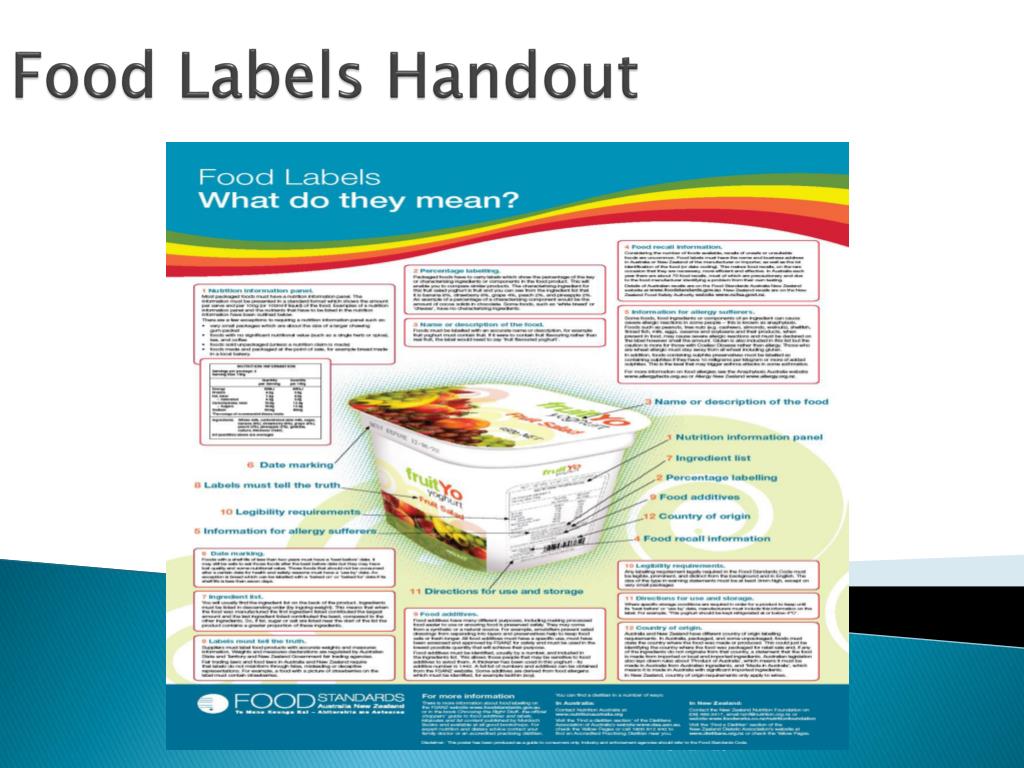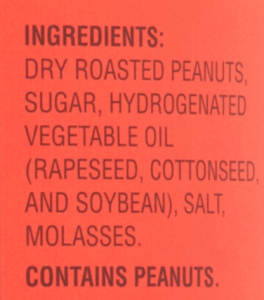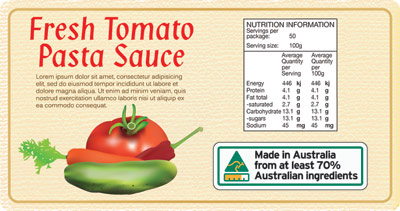45 is country of origin required on food labels
Country of origin | ACCC - Australian Competition and Consumer Commission You will find country of origin labelling on most food you buy at the supermarket, local stores, markets, online or from a vending machine. Food bought from restaurants, cafes, take-away shops, schools and caterers does not have to be labelled. Food that was packaged and labelled on or before 30 June 2018 can still be sold without the new labels. Must processed food products have a country of origin label? Retail items that meet the definition of a processed food item do not require labeling under the COOL final rule. For more information, visit Common Questions & Answers on Country of Origin Labeling.
Food labelling: country of origin - GOV.UK If all these activities took place in a single country, the label 'Origin: [name of country]' is acceptable. For the GB market, 'United Kingdom' is the origin label for beef and veal from both GB...

Is country of origin required on food labels
A Brief History and Overview of Country of Origin Labeling Requirements ... Country of Origin Labeling (COOL) laws and regulations require retailers to notify their customers of the country of origin of covered commodities, which include beef, veal, lamb, chicken, fish and shellfish, goat, pork, perishable agricultural commodities, macadamia nuts, pecans, ginseng, and peanuts. Country of origin labelling - Food Standards Country of origin labelling requirements for food is in the Country of Origin Food Labelling Information Standard 2016, under the Competition and Consumer Act 2010. These requirements became mandatory on 1 July 2018. At the same time, the Food Standards Code was amended to remove country of origin labelling requirements. Country of Origin Labeling (COOL) - Agricultural Marketing Service Country of Origin Labeling (COOL) is a labeling law that requires retailers, such as full-line grocery stores, supermarkets and club warehouse stores, to notify their customers with information regarding the source of certain foods.
Is country of origin required on food labels. How to Navigate the Country of Origin Food Labelling Requirements — Lau ... Requirements that must be met before the Australian country of origin labels can be used. When a food is grown, produced in, packed or made in Australia, it is mandatory that proportion of Australian content be disclosed. Where businesses cannot accurately identify the percentage of Australian content in a food, the claim that the food contains ... Marking of Country of Origin on U.S. Imports 12/08/2020 · Watches and clocks are also subject to the normal country of origin marking requirements of 19 U.S.C. 1304, and under these requirements, the movement’s country of origin should appear conspicuously and legibly on the dial face or on the outside of the back. In addition, watchbands should be marked with the country of manufacture of the band, unless … Chapter 13 - Country of Origin Marking - U.S. Customs and Border Protection GenerallyFor goods made in one country with no foreign inputs, determination of the country of origin is easy--it is the country of production. Increasingly, however, goods are processed in multiple countries using both domestic and foreign materials, thereby complicating the determination of the country of origin. The NAFTA provides that Canada, Mexico and the United States write specific ... Packaging and labelling | Food Standards Agency The following information must appear by law on food labels and packaging: ... The QUID tells a consumer the percentage of particular ingredients contained in a food product. This is required where the ingredient or category of ingredients concerned: (a) appears in the name of the food or is usually associated with that name by the consumer; (b) is emphasised on the labelling in …
Which foods are covered in the country of origin labeling law? - USDA Foods that must be labeled with their country of origin are: 1. Muscle cuts of beef (including veal), lamb, pork, goat, and chicken; 2. Ground beef, ground lamb, ground pork, ground goat, and ground chicken; 3. Wild and farm-raised fish and shellfish; 4. Perishable agricultural commodities (fresh and frozen fruits and vegetables); 5. Country of origin labelling - Food labelling e-learning course Unless required under a specific rule (see page on 'Further mandatory origin labelling'), an indication of country of origin or place of provenance is only ... All About Labels - Country of Origin Food Labeling Country of Origin Food Labeling Food labeling in Australia is changing. If you sell food in retail stores in Australia your products will be required to display the new labels from 1 st July 2016. What Is Country of Origin Labeling? An Overview Importers and exporters must properly identify and label the country of origin of their goods. It's used by customs authorities to identify duty rates, preferential trade agreements, trade sanctions and import quotas that may apply. Labels on goods also allow users to know their origin. What Is Country of Origin Labeling? An Overview
Country of Origin Requirements in the United States: An Overview Country of origin labeling is mandatory for all consumer products imported and sold in the United States. Country of origin labeling is often as straightforward as printing a 'Made in [INSERT COUNTRY]' on the product and its packaging. Country of Origin Marking Requirements - PackagingLaw.com The Tariff Act regulations specify that articles of foreign origin entering the United States must be marked with the English name of the COO. The marking must be legible, located in a conspicuous place, and permanent. Articles that are incapable of being marked ( e.g., liquids) are exempt, but their containers must be marked with the COO of ... CPG Sec. 560.200 Country of Origin Labeling - Food and Drug Administration CPG Sec. 560.200 Country of Origin Labeling BACKGROUND: A statement of the country of origin on the labeling of imported foods is not required by the Federal Food, Drug, & Cosmetic Act. This is a... Country of Origin Labeling - an overview | ScienceDirect Topics Country of origin labeling (7 CFR Part 60 et seq.) is a retail-level requirement that provides consumers with notification about the geographic origin of ...
Country of Origin Requirements in the United States: An Overview 27/04/2022 · Food contact products; Product Labeling. Form of Marking. The U.S. Customs and Border Protection (CBP) accepts different forms for the Country of Origin marking, such as for example: 1. Printed labels. 2. Engraving. 3. Tags, provided that they are visible and are attached to the product. 4. Adhesive labels, which can be used in some cases. However, it is not …
Labelling poster - how to read food labels Food Labels - what do they mean? ... In New Zealand, country of origin labelling is required on wine only. Further information is available on the Ministry for Primary Industries website. 12. 12. Nutrition and health claims. Nutrition content claims are claims about the content of certain nutrients or substances in a food (e.g. contains calcium). Health claims refer to a relationship …

New changes to Country of Origin Food Labelling, taking place throughout Australia | SBS Your ...
Country of origin food labels - Department of Industry, Science, Energy ... The current requirements for country of origin labelling for food came into full-effect in July 2018. We reviewed the reforms in 2021. The review examined how well the reforms: improved consumer access to information about the origin of food. clarified the origin claims businesses can make about their products.
Country of Origin Labeling (COOL) Frequently Asked Questions Country of Origin Labeling (COOL) is a consumer labeling law that requires retailers (most grocery stores and supermarkets) to identify the country of origin on certain foods referred to as "covered commodities".
Country of origin food labelling | business.gov.au May 21, 2021 — The standard mark is a requirement under the Information Standard. · A country of origin statement is text only that identifies the product's ...
Country of origin of food - Commerce Commission on the food item; on packaging; on signage located next to the food item; in a similar way. When a regulated food item is offered or advertised then the Regulations require that the origin information be disclosed as part of the offer or advertisement. The key point is that there must be a clear connection between the disclosure and the food item.
Origin labelling - European Commission Origin labelling of the primary ingredient of a food: Article 26 (3) of Regulation (EU) No 1169/2011 requires that where the origin of a food is given and is different from the one of its primary ingredient, the origin of the primary ingredient shall be given or at least indicated as being different to the origin of the food.
Origin labelling - Language selection | Food Safety Indication of the country of origin or place of provenance shall be mandatory where failure to indicate this might mislead the consumer as to the true.
Country of Origin Labeling (COOL) Frequently Asked Questions Country of Origin Labeling (COOL) is a consumer labeling law that requires retailers (most grocery stores and supermarkets) to identify the country of origin on certain foods referred to as “covered commodities”. The 2002 and 2008 Farm Bills and the 2016 Consolidated Appropriations Act amended the Agricultural Marketing Act of 1946 to require retailers to notify their customers …
Marking of Country of Origin on U.S. Imports - U.S. Customs and Border ... Acceptable Terminology and Methods for MarkingEvery article of foreign origin entering the United States must be legibly marked with the English name of the country of origin unless an exception from marking is provided for in the law.
Country of Origin Labeling of Agricultural Products Rules, Examples, Requirements, Recordkeeping More consumers are checking product and food labels after recent imported product issues and continued health education and awareness campaigns. This growing consumer interest along with other food production issues prompted the federal government to devise laws requiring suppliers to state the origin of specific covered commodities.
Mandatory country-of-origin labeling (US) - Wikipedia The US said the panel affirmed the right of the United States to require country of origin labeling for meat products. Canada and Mexico asked the WTO for another review and permission to impose more than $2 billion a year in retaliatory tariffs, and the ruling was made public in summer 2014.
Country of origin labelling for food products - Canadian Food ... The new FDR requirements are available in the Industry Labelling Tool. Food businesses have a transition period to meet them, during which they must comply with either the former or the new requirements. In Canada, there are mandatory requirements for certain food products to indicate the country of origin on their labels.
Country of origin | ACCC Country of origin food labels. Most of the foods you buy need to display country of origin labels. Look out for these labels on food packages or in-store signage. Different labelling requirements apply depending on: whether the food is grown, produced, made or packed in Australia or another country; whether the food is a ‘priority’ or ‘non-priority’ food ; how the …
Country of origin on food labels - Canadian Food Inspection Agency In Canada, there are mandatory requirements for certain food products to indicate the foreign state (definition) of origin on their labels. Although foreign states include countries as well as World Trade Organization (WTO) members, the Industry Labelling Tool commonly refers to this requirement as country of origin labelling.




/arc-anglerfish-tgam-prod-tgam.s3.amazonaws.com/public/C6KP5YSHXVHYVMFK6ZG6RTC2CI)






Post a Comment for "45 is country of origin required on food labels"